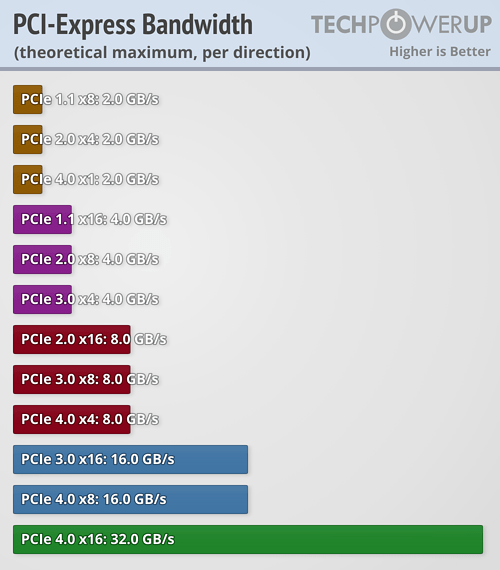 74
74
AMD Radeon RX 6600 XT PCI-Express Scaling
Test Setup »Introduction

In this article, we'll try to understand the performance impact of various PCI-Express configurations for the AMD Radeon RX 6600 XT graphics card. We've been doing PCIe scaling articles for well over a decade: RTX 3080, RX 5700 XT, RTX 2080 Ti, GTX 1080, R9 Fury X, GTX 980, GTX 480, and HD 7870. This kind of article is usually reserved for the topmost-tiered GPUs from AMD and NVIDIA, making this the first time we're evaluating a mid-range GPU from this perspective.
The basis for this article is the fact that the RX 6600 XT, and 7 nm "Navi 23" silicon it's based on, physically only features a PCI-Express 4.0 x8 bus interface. The GPU only has pins for eight PCIe lanes. This was probably a design choice made to cut costs and save pin-count on the compact GPU package. A smaller PCB footprint also makes the GPU desirable for notebook designers looking to hardwire the package directly onto the mainboard, as is the norm these days.

PCI-Express 4.0 x8 is a huge amount of bandwidth. Given that PCIe Gen 4 pushes 16 Gbps per direction, you're looking at 16 GB/s per direction; or at bandwidth that's identical to PCI-Express 3.0 x16. This should be plenty for a mid-range GPU like the RX 6600 XT, end of the story? But wait...there's a catch. When installed on older platforms with PCIe Gen 3, such as Intel 10th Gen "Comet Lake" (or older), or AMD Ryzen 2000 series (or older), the GPU is forced to operate at PCI-Express 3.0 x8, which is half the bandwidth of Gen 4 x8. And if you're on even older platforms, such as AMD FX, however unlikely, it's going to run at PCI-Express 2.0 x8, which is about a quarter of the bandwidth of Gen 4 x8.

The Radeon RX 6600 XT isn't the first time AMD designed a mid-range GPU with x8 PCIe, the RX 5500 XT from the previous RDNA generation also uses PCI-Express 4.0 x8. We didn't much care about this topic back then because those were happier times, when gamers were spoiled for choice with GPUs. In today's unfortunate environment for PC component shoppers, the RX 6600 XT and GeForce RTX 3060 are important parts, as even with scalper pricing, they can be had for around $600, which is somewhat "affordable" to gamers. Among the two, the RX 6600 XT emerged the performance king of the mid-range segment, and so here we are.
In this review, we will test the Radeon RX 6600 XT on various PCI-Express configurations that include native PCI-Express 4.0 x8, PCI-Express 3.0 x8, PCI-Express 2.0 x8, and PCI-Express 1.1 x8. With each older generation, we're effectively halving the bus bandwidth. We switch to the older PCIe generations using the motherboard's UEFI Setup program, and verify with GPU-Z.
Apr 27th, 2024 05:18 EDT
change timezone
Latest GPU Drivers
New Forum Posts
- im new to throttelstop and i think i messed it up by copying others any hints would be very much aprreciated (6)
- hacked (79)
- Ryzen Owners Zen Garden (7247)
- Post your Speedtest.net Speeds! (2256)
- Should I install Windows 10 or 11 for my new device (5)
- TechPowerUp Screenshot Thread (MASSIVE 56K WARNING) (4214)
- wireless mic for pc (1)
- My mouse randomly stops working (2)
- Horizontal black lines popping up on my screen? (14)
- MSI Stealth GS65 9SF settings after repaste (0)
Popular Reviews
- Ugreen NASync DXP4800 Plus Review
- HYTE THICC Q60 240 mm AIO Review
- MOONDROP x Crinacle DUSK In-Ear Monitors Review - The Last 5%
- Upcoming Hardware Launches 2023 (Updated Feb 2024)
- Thermalright Phantom Spirit 120 EVO Review
- FiiO K19 Desktop DAC/Headphone Amplifier Review
- Quick Look: MOONDROP CHU 2 Budget In-Ear Monitors
- AMD Ryzen 7 7800X3D Review - The Best Gaming CPU
- Alienware Pro Wireless Gaming Keyboard Review
- ASUS Radeon RX 7900 GRE TUF OC Review
Controversial News Posts
- Windows 11 Now Officially Adware as Microsoft Embeds Ads in the Start Menu (137)
- Sony PlayStation 5 Pro Specifications Confirmed, Console Arrives Before Holidays (117)
- NVIDIA Points Intel Raptor Lake CPU Users to Get Help from Intel Amid System Instability Issues (106)
- AMD "Strix Halo" Zen 5 Mobile Processor Pictured: Chiplet-based, Uses 256-bit LPDDR5X (103)
- US Government Wants Nuclear Plants to Offload AI Data Center Expansion (98)
- AMD's RDNA 4 GPUs Could Stick with 18 Gbps GDDR6 Memory (95)
- Developers of Outpost Infinity Siege Recommend Underclocking i9-13900K and i9-14900K for Stability on Machines with RTX 4090 (85)
- Windows 10 Security Updates to Cost $61 After 2025, $427 by 2028 (84)